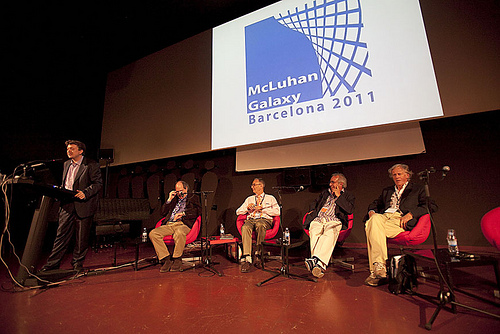
CCCB (C) Gloria Solsona, 2011.
In this brief text I will take up some thoughts on current interpretations of the work of Marshall McLuhan that I dropped in an earlier post on my blog Hipermediaciones. The starting question might be: how do we read McLuhan? What are we making his texts say? I think there are several ways to approach the explosive and diverse work of the Canadian author. Some readings are based on very specific disciplinary fields: there are readers from media studies, other from the education sphere, there are even people who come to McLuhan from marketing or publishing. Each of them build a McLuhan to measure, and often find in his texts interesting answers but and new challenges. McLuhan boasted of this very thing as one of the lecturers at McLuhan Galaxy Barcelona 2011 reminded us. McLuhan wanted us to think.
Other possible readings of McLuhan travel throughout the disciplinary spectrum. One of the most widespread ways of interpreting it is that it focuses on the predictive character of his ideas and aphorisms. During the McLuhan Galaxy Barcelona 2011 and again at conferences, panel discussions or communications sessions, the predictive ability of McLuhan was present at the talks. I myself have been actively involved in this game that McLuhan is read with an eye on the paper and the other in the reality of the twenty-first century (see this post at Digitalismo, 2010). McLuhan died in 1980 but would have anticipated the web, Facebook, the school crisis, and if we stay on track event the victory of Barça over Manchester on the nightof May 28, 2011 …
Was McLuhan our Nostradamus? I must confess that after this full-immersion in three days we had in Barcelona 2011 Galaxy McLuhan we left saturated of MacLuhan predictions. I think we are reducing the complexity of his thought and contributions to a trade show of a magician with a crystal ball. McLuhan was an acute analyst of the reality of the postwar years, when television was nthe ew media that broke all the schemes and the global agenda jumped from the barricades of Paris to some footsteps at the Sea of Tranquility in the lunar surface. That was the reality that McLuhan analyzed and inspired, not our reality, full of social networking, convergence and disintermediation.
Faced with a stagnant academic world torn between European critical schools (“we must denounce the bourgeois ideology of the media”) and U.S. empirical studies (“we must study the effects of TV on Children”) McLuhan broke with a sideways and irreverent glance, impossible to fit in the academic parameters of his time. McLuhan did not stay in the observation of pure empirical data but had the necessary clarity to frame this element in a larger process. In other words, McLuhan identified and synthesized patterns brilliantly in his famous aphorisms. With “the medium is the message” McLuhan was identifying a pattern and, for the same price, he proposed a new way to interpret the media and culture.
Rather than reading McLuhan with a microscope to identify predictions, I think we will pay a better tribute by trying to rebuild his view on things, discovering the cognitive and discursive “protocols” that led scientists to break the mold and create a different view of reality. As a summary: it is better to interpret the media today with McLuhan’s eyes than trying to try create a story where McLuhan would have predicted our media reality 50 years ago. The reading I propose should be devoted less to finding predictions and more to identifying patterns in his speech. What I propose, in other words, is a McLuhan reading of McLuhan.

Leave a comment